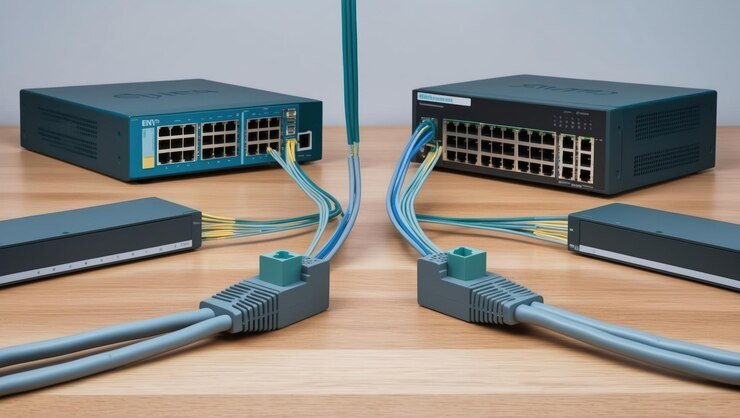
introduction to WAN IP Addresses
When you connect to the internet, your device is assigned an IP address. But have you ever wondered what type of IP address you’re using? Understanding the difference between a Local Area Network (LAN) and a Wide Area Network (WAN) can open up a world of possibilities for network management and online activities. How to external WAN IP address is crucial for various tasks such as remote access, hosting servers, or simply ensuring that certain applications function properly.
In this digital age where connectivity reigns supreme, knowing how to obtain an external WAN IP address can enhance your online experience. Whether you’re looking to host gaming sessions with friends or protect your browsing privacy, grasping these concepts will empower your tech-savvy journey. Let’s dive into everything you need to know about obtaining that coveted external WAN IP!
Understanding the Difference Between a LAN and a WAN
A Local Area Network (LAN) and a Wide Area Network (WAN) serve different purposes in the realm of connectivity.
A LAN connects devices within a limited geographic area, such as homes or offices. It’s typically faster and more secure due to its confined scope. Devices can communicate directly without needing an intermediary.
On the other hand, WAN spans broader distances, linking multiple LANs across cities or even continents. This type of network relies on various communication links like leased lines, satellites, or public networks.
Latency can be higher in a WAN compared to a LAN because data travels further distances. Additionally, while LAN configurations often involve simple setups using routers and switches, WANs require complex architectures that facilitate long-distance communication effectively. Each has distinct characteristics tailored to specific networking needs and environments.
How to Find Your Current External WAN IP Address
Finding your current external WAN IP address is straightforward. You can use various methods, but one of the simplest ways is by visiting a website designed for this purpose.
Open your preferred web browser and go to sites like “whatismyip.com” or “ipinfo.io.” These platforms will instantly display your external IP address at the top of the page.
Alternatively, you can check through your router’s settings. Enter your router’s IP address into a new browser tab—typically something like 192.168.1.1 or 192.168.0.1—and log in with your credentials.
Once logged in, navigate to the status section where it often shows both LAN and WAN settings; you’ll find your external IP listed there as well.
These quick methods allow you to easily identify and keep track of changes to your WAN IP address whenever needed.
Benefits of Having an External WAN IP Address
Having an external WAN IP address opens up a world of possibilities. It allows you to access your devices remotely, whether it’s a home server or security camera. This capability is essential for those who need constant access to their files and applications.
With an external WAN IP, hosting services becomes straightforward. You can run websites or game servers from the comfort of your home without complications associated with port forwarding.
Another important benefit is enhanced online gaming experiences. A static external WAN IP reduces lag and improves connection stability, providing smoother gameplay sessions.
For businesses, this type of IP address enables better communication and collaboration tools. Remote employees can connect seamlessly to company networks as if they were on-site.
Having an external WAN IP enhances flexibility in both personal and professional scenarios while boosting efficiency significantly.
How to Obtain an External WAN IP Address
How to external WAN IP address can be crucial for various online activities, whether you’re hosting a server or requiring remote access. The first step often involves checking with your Internet Service Provider (ISP). Many ISPs assign dynamic IP addresses that change periodically. If you need a static one, inquire about upgrading your service.
Another option is using Dynamic DNS services, which map your changing IP to a fixed domain name. This way, even if the IP changes, you can still connect seamlessly.
Alternatively, setting up a Virtual Private Network (VPN) might be beneficial. VPNs not only provide security but can also give you an external WAN IP based on the server’s location.
Understanding these methods will empower you to manage your network needs effectively while keeping connectivity smooth and reliable.
Alternatives to Obtaining an External WAN IP Address
Sometimes, obtaining an external WAN IP address isn’t the most straightforward task. Fortunately, there are alternatives that can help you navigate your networking needs without directly acquiring one.
One option is to leverage a cloud-based service. These platforms often provide virtual servers with their own public IP addresses. This way, you can route traffic through them without needing a direct connection to your home network.
Another solution involves utilizing remote access software. Tools such as TeamViewer or AnyDesk let you connect to devices on your local network remotely, which can be beneficial if you’re looking for specific functionalities tied to your LAN setup.
Peer-to-peer networks offer unique benefits by allowing users to connect directly with each other’s machines over the internet. This method bypasses traditional ISP limitations while enabling seamless file sharing and communication among users.
Methods for Obtaining an External WAN IP Address
When you need to obtain an external WAN IP address, there are several methods at your disposal.
One straightforward approach is contacting your Internet Service Provider (ISP). They can provide a static or dynamic IP address based on your needs and plan.
Another option involves using a Dynamic DNS service. This tool helps map a domain name to your changing WAN IP, making remote access much easier without constant manual updates.
Setting up a Virtual Private Network (VPN) also grants you an external WAN IP. By connecting through the VPN server, you utilize its public IP while securing your connection.
Each method has its pros and cons depending on your requirements for stability, security, and control over the WAN environment. Choose wisely based on what fits best with how you intend to use it.
A. Contacting Your Internet Service Provider
Reaching out to your Internet Service Provider (ISP) is a straightforward way to obtain your external WAN IP address. Most ISPs can provide this information easily upon request.
When you contact them, be prepared with your account details. This includes any security questions that may arise during the process. Being ready can speed up the inquiry and make it smoother.
Ask specific questions about obtaining a static or dynamic IP address, based on what suits your needs best. Some providers offer both options, while others might only have one available.
Keep in mind that some ISPs charge extra fees for static IP addresses. Knowing these details beforehand can help you decide if it’s worth pursuing further.
Always remember to ask about the potential impact of changing your IP address on existing services or devices connected to your network.
B. Using a Dynamic DNS Service
Dynamic DNS (DDNS) services offer a practical solution for users who need to access their devices remotely without worrying about changing IP addresses. This is especially useful for those with dynamic WAN IPs assigned by ISPs.
By registering with a DDNS provider, you can link your external WAN IP address to a domain name. Whenever your IP changes, the service updates the record automatically. This means you can always reach your network using the same easy-to-remember domain.
Setting up DDNS is usually straightforward. Most routers support this feature directly in their settings, allowing seamless integration into your network. Just enter your credentials and preferred hostname, and you’re good to go.
Many providers offer free or low-cost options, making it accessible for both personal and business use. With DDNS, remote access becomes simpler and more reliable—no more guessing if you’ve got the right IP!
C. Setting up a Virtual Private Network (VPN)
Setting up a Virtual Private Network (VPN) can be an effective way to obtain an external WAN IP address. A VPN creates a secure tunnel between your device and the internet, masking your actual IP address.
When you connect through a VPN server, you are assigned an external WAN IP from that server’s location. This gives you access to geo-restricted content while enhancing privacy.
Choosing the right provider is essential. Look for one that offers reliable service, strong encryption protocols, and plenty of servers worldwide.
Installation is usually straightforward. Most VPNs come with user-friendly apps for various devices. After installation, simply log in and select a server location to change your external WAN IP seamlessly.
Remember, not all VPNs are created equal; some may slow down your connection speed or have limited bandwidth options. Do thorough research before making a choice.
Tips for Maintaining Your External WAN IP Address
Maintaining your external WAN IP address is crucial for consistent access to your network. Start by regularly checking your IP address through online tools or command prompts. This helps you stay informed about any changes.
Consider investing in a static IP if stability is vital for your operations. Static addresses don’t change, providing reliable connectivity for remote access and hosting services.
Another tip is to configure settings on your router that minimize disconnections. Many routers offer options to extend lease times for dynamic IPs, which can reduce frequency of changes.
Keep an eye on firmware updates from your ISP and router manufacturer. Updates often enhance performance and security, contributing to the longevity of your current IP setup while safeguarding against potential vulnerabilities.
Potential Challenges and Solutions
Obtaining an external WAN IP address can come with its own set of challenges. One common hurdle is dynamic IP addresses that change frequently. This makes remote access tricky and unpredictable.
A simple solution is to use Dynamic DNS (DDNS). It allows you to link your changing IP address with a fixed domain name, ensuring consistent access no matter the fluctuations.
Another potential issue lies in ISP restrictions. Some providers limit external access or assign private IPs for residential users. If this is the case, contacting your ISP directly might yield options for obtaining a static WAN IP address.
Security concerns also arise when exposing devices to the internet. Implementing firewalls and strong passwords can mitigate these risks effectively while maintaining accessibility.
Conclusion
Understanding how to obtain an external WAN IP address can significantly enhance your online activities. Whether you’re hosting a server, accessing devices remotely, or ensuring smooth communication between networks, having a static or dynamic external IP is essential.
The distinction between LAN and WAN is crucial for grasping the broader internet landscape. A clear understanding helps you make informed decisions about networking configurations and security measures.
Finding your current external IP address is straightforward and can be done through various online services. It’s beneficial to know this as it’s often the first step in troubleshooting network issues or setting up new devices.
Having an external WAN IP offers numerous advantages. It allows for better remote access capabilities and clearer communication with other systems worldwide.
Obtaining one can be accomplished in several ways. You might contact your Internet Service Provider directly, utilize Dynamic DNS services for ease of access, or set up a VPN that suits your needs best.
While acquiring an external WAN IP may come with challenges—like potential costs from ISPs or configuring settings—adequate tips are available to help maintain its stability once obtained.
With these insights at hand, you’ll be ready to navigate the world of networking more effectively while enjoying all the benefits that come with having an external WAN IP address in today’s digital age.
RELATED POSTS
View all


